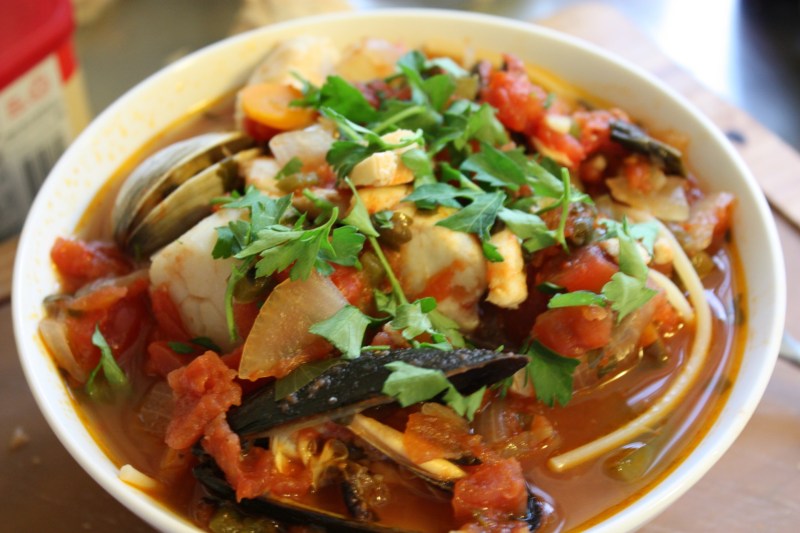Cioppino is one of the most satisfying dishes to both make and eat that we can think of. The Italian-inspired seafood stew is very much informed by the catch of the day, meaning it’s fresh, rustic, and all kinds of tasty.
The dish is essentially an Americanized take on Italian cooking, with a very coastal influence at play. The name itself is borrowed from a similar soup out of Liguria. It was born in San Francisco in the late 19th century as immigrants from Genoa fished along the wharves of the bay. Legend has it, those with poor fishing luck would have their pot filled with whatever fellow fishermen were willing to share. The charitable extras ended up framing the cioppino. Think of it as a version of gumbo, plucked from Louisiana and set to the ingredients of California and the Pacific Northwest.
Related Reading
One recipe we’re especially fond of is that of Greg Higgins. The man behind Portland’s original farm-to-table restaurant, Higgins, offered his own tasty version along with a few tips on putting it together. “For me, cioppino is our West Coast version of the classic Mediterranean fishermen’s stews,” Higgins says.

How does he make it? For starters, the wider array of fish and shellfish you have at your disposal, the better. “You can always substitute or add more goodies to the pot,” he continues. “Prawns, calamari, oysters, cockles, perhaps even some gooseneck barnacles.” Higgins’ version utilizes citrus and sweet spices to elevate and bring out all of the brininess of the other ingredients. “Likely, it’ll take more time to assemble all the ingredients than actually cook the dish but once you do the rewards are obvious,” he says.
What does one serve with cioppino? As the main event, the dish doesn’t need much else. Higgins likes a generous green salad and a crusty loaf of bread for dipping. Oh, and a good bottle of wine. We suggest something like Albariño, Pinot Blanc,or moderately-oaked (if at all) Chardonnay. However, it can vary depending on the fish you’re using. If salmon is in the mix, a medium-bodied red like Pinot Noir. Which makes a lot of sense if you like to drink the kind of wine that’s grown where the dish you’re enjoying comes from.
For the cooking wine, Higgins suggests a fruity and robust Zinfandel to even out the intensity of the broth. And at home, he likes to add a kick with some fresh habanero from his garden (“a little habanero is good for everyone,” he says).
Higgins Cioppino
Ingredients:
- 2.5 cups crushed San Marzano tomatoes
- 2 cups red wine (Higgins likes Zinfandel)
- 3 tablespoons olive oil
- 4 tablespoons garlic, minced
- 1 shallot, peeled and minced
- 1 cup onion, diced (half-inch)
- 1 teaspoon chili flakes
- 1 teaspoon basil
- 1 teaspoon oregano
- 1 teaspoon fennel seeds
- 1 pound halibut, albacore, Chinook salmon or rockfish, diced (1-inch)
- 1 pound Dungeness crab in shell, cleaned, cracked, and broken into sections
- 1 pound hardshell clams, rinsed well
- 1 pound mussels, de-bearded and rinsed well
- 1 orange, zested
- 1 cinnamon stick
- 4 whole cloves
- .5 cup celery leaves chopped
- .5 cup Italian parsley leaves
- salt and pepper
- garlic bread
Method:
- In a heavy saucepan over medium-high heat, sauté the garlic & chili flakes in the olive oil, 2-3 minutes. Add the onions, shallot, basil, oregano, and fennel seeds, cook for 2-3 minutes till the onions are translucent.
- Add the red wine and tomatoes, bring to a simmer and reduce the heat to medium-low. Simmer 20-25 minutes and season to taste with salt and pepper, remove from the heat.
- Layer the shellfish into a large saucepan and add the orange zest, cinnamon, cloves, and celery leaves. Pour the sauce over and top with the diced fish. Bring to a simmer and cover. Cook till the fish is just cooked and the clams and mussels are open.
- Garnish with the parsley leaves and serve with garlic bread and a wine of your choice.


